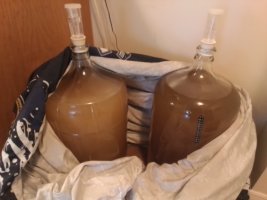ClawsMcPaws
Member
So my first batch is still fermenting (down to 1.042, may 24th, from 1.130, Feb 25th) and my second batch has complete stopped at 1.044 (3 straight weeks same reading from 1.109 started March 31st). My ph reading on both batches is just under 4. I'm fine with waiting out my first batch but want to try and restart the second so I've thought about these options,
1) add some more yeast, I already added a pack of EC1118 that came with the chardonnay juice i boughtto make a pyment with but didnt do anything. Id be adding mangrove jack M05, may use goferm and rehydrate even though the package says to just add it to the must (thoughts on rehydration of M05 would be awesome)
2) rack off the lees to a second carboy and perform the same as #1
My third thought is rack off half of each batch into new carboys, possibly adding some new yeast (1/2 pack in each) but don't know what effect it would have especially where my 1st has reached or passed 2/3 sugar break and I wasn't going to disturb it more than to check gravity every few weeks. Has anyone mixed batches like this before?
1) add some more yeast, I already added a pack of EC1118 that came with the chardonnay juice i boughtto make a pyment with but didnt do anything. Id be adding mangrove jack M05, may use goferm and rehydrate even though the package says to just add it to the must (thoughts on rehydration of M05 would be awesome)
2) rack off the lees to a second carboy and perform the same as #1
My third thought is rack off half of each batch into new carboys, possibly adding some new yeast (1/2 pack in each) but don't know what effect it would have especially where my 1st has reached or passed 2/3 sugar break and I wasn't going to disturb it more than to check gravity every few weeks. Has anyone mixed batches like this before?































![Craft A Brew - Safale S-04 Dry Yeast - Fermentis - English Ale Dry Yeast - For English and American Ales and Hard Apple Ciders - Ingredients for Home Brewing - Beer Making Supplies - [1 Pack]](https://m.media-amazon.com/images/I/41fVGNh6JfL._SL500_.jpg)


























